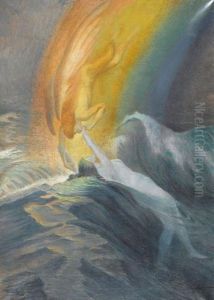Max Francois - Rodolphe Von Geymuller Paintings
Max François Rodolphe Von Geymüller, better known as Rodolphe Von Geymüller, was an Austrian architect, art historian and researcher primarily known for his significant contributions to the study of Renaissance architecture. Born on September 23, 1865, in Vienna, Austria, Geymüller hailed from an aristocratic family which allowed him access to a privileged education and extensive travel opportunities that were crucial in shaping his future career.
After studying architecture at the Vienna University of Technology, Geymüller continued his education in Paris, where he was greatly influenced by the French approach to art and architecture. His passion for Renaissance architecture was ignited during these formative years. He dedicated his life to the meticulous study of Renaissance buildings, striving to understand the mathematical and geometrical principles underlying their design.
Geymüller's work was characterized by a rigorous analytical approach. He was particularly fascinated by the architectural drawings and plans of the period, which he collected and studied extensively. His efforts culminated in the publication of several important works, including 'The Drawings of the Florentine Painters' and 'Die Architektur der Renaissance in Toscana' (Architecture of the Renaissance in Tuscany), which remain influential to this day. These publications were remarkable for their detailed documentation and analysis of architectural forms and were invaluable to both scholars and practicing architects interested in Renaissance architecture.
Beyond his scholarly work, Geymüller's expertise was also sought after in the field of architectural preservation and restoration. He was involved in several restoration projects, where he applied his deep understanding of historical construction techniques and aesthetic principles. His commitment to authenticity in restoration set standards for future generations of conservators.
Rodolphe Von Geymüller's contributions to art history and architectural scholarship were widely recognized during his lifetime, and his work continues to be a reference point for contemporary studies on Renaissance architecture. He passed away on October 11, 1942, leaving behind a legacy that continues to inspire and inform the fields of art history and architectural preservation.

